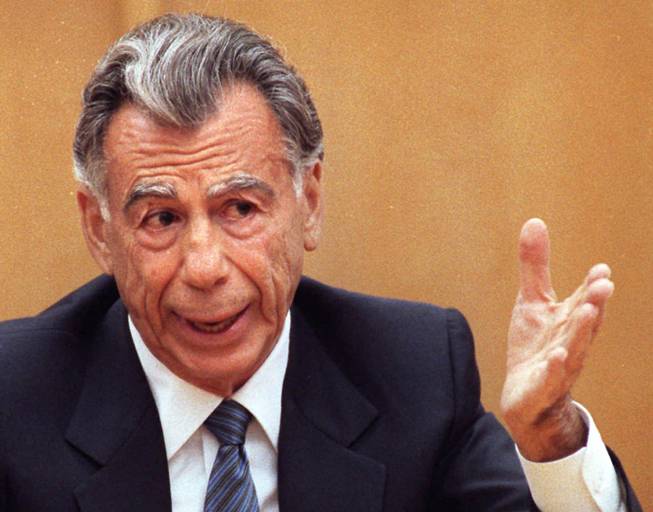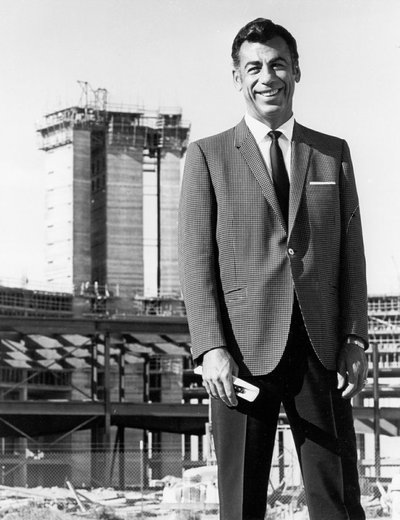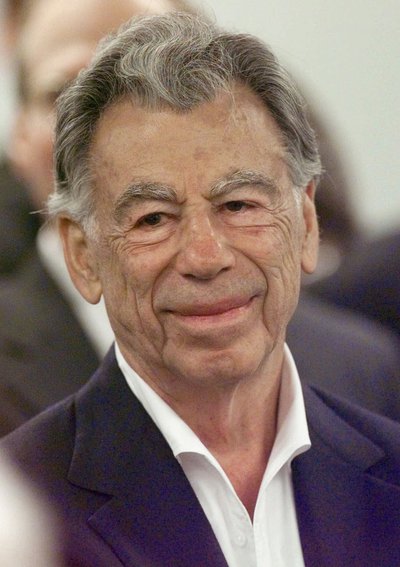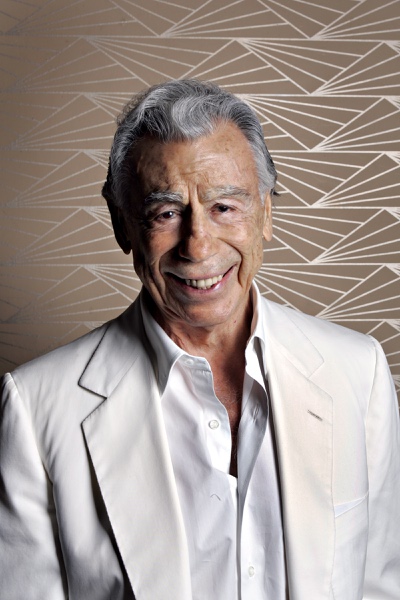
Kevork Djansezian / AP
Kirk Kerkorian is shown in this 1992 file photo.
Published Tuesday, June 16, 2015 | 8:41 a.m.
Updated Tuesday, June 16, 2015 | 3:59 p.m.
From the archives:
- Kirk Kerkorian: Recently married and ‘continues to move forward’
- Steve Wynn on Kirk Kerkorian’s L.V. ‘fatherhood’
- Joan Dangerfield-Kirk Kerkorian were ‘engaged,’ but never planned to marry
- Kirk Kerkorian’s gift feeds future
- Kirk Kerkorian’s $18 million pushes Andre Agassi Grand Slam haul to $26.1 million
- Kirk Kerkorian: CityCenter is ‘simply the most amazing’ Vegas project ever
Billionaire businessman Kirk Kerkorian spent a lifetime outdoing himself, whether it was being the biggest studio boss in Hollywood or one of America’s leading automaker investors or by building spectacular Las Vegas resorts, each one grander than the previous.
Three times he built what was heralded as “the world’s largest hotel” — the International Hotel (now the Westgate) in 1969, the MGM (now Bally’s) in 1973 and the MGM Grand in 1993, earning him the endearing title of “the father of the Las Vegas megaresort.”
Even when it came to giving away much of his vast fortune, Kerkorian did things bigger and better than most, creating the Lincy Foundation that provided a billion dollars to rebuild earthquake-devastated Armenia and tens of millions of dollars to Southern Nevada charities.
Kerkor “Kirk” Kerkorian, who during his long and colorful life owned the Metro-Goldwyn-Mayer film studio in Hollywood, key percentages of Ford Motor Co. and General Motors and at one time or another 16 major Las Vegas hotel-casinos died Monday, June 15, 2015, nine days after his 98th birthday. He died at home in Los Angeles of natural causes.
“Kirk Kerkorian was one of a handful of people who built the city he loved — Las Vegas,” said Brian Greenspun, CEO, publisher and editor of Greenspun Media Group. “He was quiet; he was shy; he was unassuming, and yet he was a giant of American capitalism whose vision and love of the deal helped catapult Las Vegas to the top of the world when it came to building the megaresorts for which we are so famous.”
“Kirk was a dear friend of my parents and a cherished friend of mine,” Greenspun said. “His business genius will be missed by all, and his warm and endearing friendship and loyalty will be sadly missed by all of those people lucky enough to have enjoyed it.”
Las Vegas business and community icon Steve Wynn said he admired and respected Kerkorian “in every possible way.”
“I started playing tennis with Kirk when I was 26 years old at the Las Vegas Country Club in 1968,” Wynn said. “I have been proud to be his friend ever since. Over the years, we did deals together and enjoyed life. He was a man who lived every day to its fullest and although we will miss him, we know that Kirk in his time didn’t miss a thing.”
Kerkorian, whose holdings are controlled by his Beverly Hills-based company, Tracinda Corporation, of which he was longtime president and CEO, first came to Las Vegas in 1944 for the reason many people visit the neon desert oasis — simply to gamble.
As a pilot who ferried war planes during World War II, he spent about three years as a gambler before quitting the habit in 1947.
That year, he started a small charter company, LA Air Service, and flew gamblers from Southern California to Las Vegas. As the venture grew, he obtained some U.S. government cargo contracts for his charter service and changed the name to Trans International Airlines, which he sold to TransAmerica in 1968 for $104 million. Financially, he never looked back.
Signs that Kerkorian was a real estate visionary in Las Vegas were realized early on when, in 1962, he spent $960,000 to purchase 80 acres of Strip property across from the Flamingo hotel-casino. At first, Kerkorian rented the land to Jay Sarno, who built Caesars Palace on the site in 1966, then outright sold the land to Caesars in 1968 for $9 million.
A year earlier, Kerkorian bought 82 acres on Paradise Road for $5 million and built the International Hotel, then the world’s largest hotel with 1,500 rooms.
To fill his mammoth 4,200-seat showroom, Kerkorian brought in two of the biggest names in entertainment — Barbra Streisand to open the facility and Elvis Presley, who until his death in 1977, set Las Vegas showroom attendance records that still stand.
Eventually, Kerkorian bought the historic Flamingo resort then sold both of his hotels to Hilton, which renamed the International Hotel the Las Vegas Hilton and the Flamingo the Flamingo Hilton.
Kerkorian’s next project was to build a towering resort with a theme based on the famed MGM Studio that he had purchased in 1969. Appropriately named the MGM hotel-casino, it overtook the International in number of rooms — 2,084 — to become the world’s largest hotel at the time.
Of note, Kerkorian hired architect Martin Stern Jr. to build both the International and original MGM hotels.
On Nov. 21, 1980, the MGM burned during what is considered the worst disaster in Las Vegas history, killing 87 people. The hotel reopened eight months later and, in 1986, Kerkorian sold the MGM Las Vegas and MGM Reno to Bally Manufacturing for $594 million. The Las Vegas property was renamed Bally’s.
In September 1989, Kerkorian outdid himself again by announcing his company would build another Hollywood-themed complex on the Las Vegas Strip — the $700 million MGM. (The price tag eventually grew to $1 billion.)
MGM acquired land upon which the old Marina Hotel and Tropicana Country Club stood. Construction on the MGM Grand Las Vegas began on that site in October 1991, and the resort opened 26 months later as the new world’s largest hotel with 5,000 rooms.
In 2000, Kerkorian’s gaming empire increased several fold when he purchased Mirage Resorts from Steve Wynn that May for $6.4 billion.
Kerkorian took over ownership of the Mirage, Treasure Island, Bellagio, downtown’s Golden Nugget and the Boardwalk and half interest in the Monte Carlo, all in Las Vegas; the Golden Nugget in Laughlin; and the Beau Rivage in Mississippi. Kerkorian later sold the Treasure Island for $750 million to fellow billionaire and former New Frontier owner Phil Ruffin.
In August 2000, Kerkorian’s company became MGM Mirage. In June 2010, it became MGM Resorts International. By 2014, Kerkorian’s company was the second largest gaming conglomerate in the world, based on annual revenues.
During his lifetime, Kerkorian also owned the Desert Inn and the Sands hotels, which he purchased from Howard Hughes. He sold the Sands to Sheldon Adelson and the DI to ITT Sheraton. His company also built or owned New York-New York, Circus Circus, Mandalay Bay, the Luxor, Excalibur and Slots-A-Fun.
But the crowning jewel in Kerkorian’s resort empire had to be CityCenter, a 16.8 million-square-foot, mixed-use, urban complex on 76 acres on the Strip that opened in 2009. A joint venture of MGM Resorts International and Dubai World, it has been heralded as the largest privately funded construction project in U.S. history.
Although Kerkorian long had a policy of not granting interviews to the news media, he did issue a statement through a spokesperson at the ribbon-cutting ceremony for CityCenter in December 2009: “Of all of the wonderful Las Vegas properties with which I’ve been associated, CityCenter is simply the most amazing.
“I’m extremely excited to see the public’s reaction and look forward to seeing how it changes Las Vegas.”
CityCenter properties include the Aria, Veer Towers, Mandarin Oriental, Crystals and Vdara.
Jim Murren, chairman and CEO of MGM Resorts International, said the company and its 62,000 employees were honoring Kerkorian, who he described as a “great man, a great business leader, a great community leader, an innovator and one of our country’s greatest generation.”
Flags at MGM Resorts properties are flying at half-staff through sunset on Wednesday and a video tribute to Kerkorian will appear on company marquees on Wednesday. Kerkorian also will be honored tonight with a video/pictorial retrospective on the Viva Vision canopy at the Fremont Street Experience.
“Mr. Kerkorian combined brilliant business insight with steadfast integrity to become one of the most reputable and influential financiers of our time,” Murren said. “Personally, he was a friend and coach who taught me the importance in looking forward, and to look back only to understand how things could be done better.”
Alex Yemenidjian, Kerkorian’s longtime friend and former chairman and CEO of MGM Resorts International, called Kerkorian “one of those rare and exceptional individuals who set the standards by which excellence is measured.”
“He was kind to everyone, a loyal friend and a gentleman’s gentleman. In business, Kirk was brilliant and could see around corners,” Yemenidjian said. “But in his heart, Kirk was really a philanthropist who lived modestly and gave extravagantly. He has profoundly enriched the lives of many without expecting or accepting anything in return, and that is an admirable legacy. I love him and I will miss him terribly.”
Born June 6, 1917, in Fresno, Calif., to Armenian immigrant parents, Kerkorian was a junior high school dropout who for a while fought as an amateur boxer and, as a teenager, installed furnaces and herded cattle.
He took up flying in his early 20s, taking lessons at a Mojave Desert-based flight school. After earning a commercial pilot’s license, Kerkorian joined the British Royal Air Force at the start of World War II and spent much of the war ferrying planes from Canada to Scotland.
Being paid $1,000 per plane delivery, Kerkorian safely delivered more than 30 aircraft to allied forces to assist in the war effort. Upon his discharge in 1944, he used his military earnings to buy a Cessna and for a while made his living as a pilot for hire.
In addition to his Las Vegas holdings, Kerkorian acquired MGM studios in 1969 and immediately began to stabilize the company’s financial position by selling off its collection of movie memorabilia.
During his years of ownership, the studio expanded its film library and acquired the United Artists studio in 1981. Five years later, he sold both studios to Atlanta television mogul Ted Turner, who 74 days later sold the MGM name and the pre-1984 film library back to Kerkorian.
Kerkorian later sold his MGM/UA studio lot to Lorimar pictures. After a series of sales, Kerkorian, in 1996, wound up again buying the MGM Studio and soon expanded it by purchasing Orion Pictures and other film-related businesses. In 2005, Kerkorian sold MGM for the final time to a group which included Sony.
In 1995, Kerkorian attempted a takeover of the Chrysler Corp. but was rebuffed. A year later, Kerkorian abandoned his plans and sold the Chrysler stock he had acquired over time for a huge profit.
Kerkorian at one time owned nearly 10 percent of General Motors, but by 2006, he had sold nearly all of his shares in the company without incurring a loss, a fate not shared by other GM shareholders who waited too long.
In 2007, Kerkorian again went after Chrysler, making a $4.58 billion bid to Daimler-Chrysler, which expressed interest in the offer. However, the positive response to Kerkorian’s bid opened the floodgates for other investors to make offers, including Cerberus Capital Management, which wound up buying Chrysler for $7.4 billion.
In 2008, Kerkorian turned his attention to buying stock in Ford Motor Co. He spent $1 billion to acquire 6 percent ownership in Ford. But after the company lost two thirds of its value during the recession, Tracinda began to sell the Ford stock at what was estimated to be a half-billion-dollar loss. By year’s end, Kerkorian had sold all of his Ford shares.
Hit exceptionally hard by the devastating recession of the early 21st century, Kerkorian saw his vast wealth decrease from an estimated $16 billion in 2008 to just less than $4 billion in 2013, according to Forbes magazine.
In his off-time, Kerkorian enjoyed playing tennis, especially competing in tournaments.
He refused countless proposals during his lifetime to have buildings named in his honor. But Kerkorian’s charitable efforts, most notably through his Lincy Foundation — the name came from combining the first names of his two daughters, Linda and Tracy, as does Tracinda — are legendary.
Through Lincy, which Kerkorian established in 1989, he gave $1 billion to Armenia to help rebuild the northern sector of the country after a massive 1988 earthquake.
In 2011, Kerkorian’s Lincy group gave $18 million to the Andre Agassi Foundation for Education at Agassi’s 16th annual Grand Slam for Children. Kerkorian and Las Vegas tennis legend Agassi had been longtime friends.
With tears in his eyes, Agassi announced Kerkorian’s gift during the gala at the Wynn Las Vegas’s Lafite Ballroom, bringing the total raised that evening to $26.1 million.
In August 2009, an initiative to raise money to advance education, health care and social services in Nevada was launched at UNLV with a $14 million grant from Kerkorian’s foundation.
The gift funded The Lincy Institute at UNLV to identify and apply for national grants to improve the quality of life in Nevada. The institute works with dozens of public agencies and nonprofit organizations on issues including health care, education, child and family advocacy, homelessness, suicide prevention and physical disabilities.
Kerkorian said through a spokesman that he made that gift in honor of his friend of more than 40 years, Senate Minority Leader Harry Reid.
Lincy also was instrumental in the funding of Las Vegas’ Three Square Food Bank, which has become a model for food bank operations nationwide.
After 22 years of philanthropy, the Lincy Foundation was dissolved in 2011. Its last act of kindness came on Feb. 14 of that year when Kerkorian donated nearly $200 million to UCLA to create the Dream Fund at UCLA.
Reid talked about Kerkorian on the Senate floor this morning.
“When history books are written, they’ll say a lot about this good man,” said Reid, who met Kerkorian as a young lawyer.
“He was just a really interesting, wonderful man. He is one of the personalities I will never forget. My relationship with him is one of the special things in my life,” Reid said. “I feel so fortunate to be able to talk on a personal basis about this man. He was one of a kind.”
Married four times, Kerkorian spent his later years as an eligible bachelor, almost tying the knot for a fourth time as late as 2012.
His first marriage to Hilda Schmidt in 1942 ended in 1951.
Kerkorian met his second wife, British-born dancer/choreographer Jean Maree Harbour-Hardy at the old Thunderbird Hotel on the Strip and married her in 1954. They had the two daughters and remained friends after their divorce in 1984 following 30 years of marriage.
Kerkorian’s marriage lasted one month in 1984 to professional tennis player Lisa Bonder, who was 48 years younger than Kerkorian.
In June 2012, on the eve of his 95th birthday, reports surfaced that Kerkorian was seriously dating Joan Dangerfield, widow of comedian Rodney Dangerfield. That September, they announced their engagement. A spokesman for the couple confirmed at that time that the two had been dating since December 2009.
He was briefly married a fourth time but by Valentine’s Day 2013, Kerkorian’s relationship status had reverted to single, according to published reports.
In addition to his daughters, survivors include his niece Jewel and nephew Roger.
Ed Koch is a former longtime Sun reporter.





Join the Discussion:
Check this out for a full explanation of our conversion to the LiveFyre commenting system and instructions on how to sign up for an account.
Full comments policy